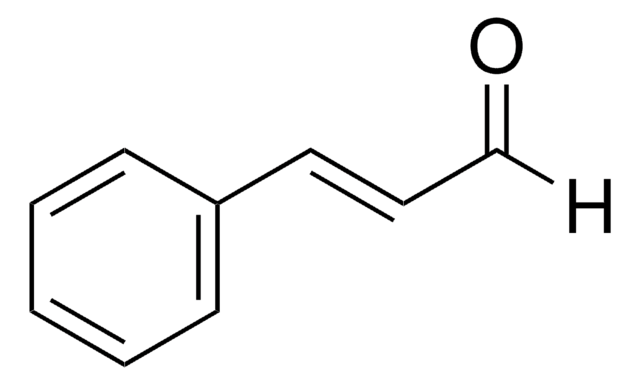W230316
Citral
natural, ≥96%, FCC, FG
Synonym(s):
3,7-Dimethyl-2,6-octadienal, Geranial and neral mixture
About This Item
Fragrance grade
Halal
Kosher
natural
Recommended Products
biological source
Litsea cubeba Pers.
Quality Level
grade
FG
Fragrance grade
Halal
Kosher
natural
Agency
follows IFRA guidelines
reg. compliance
EU Regulation 1223/2009
EU Regulation 1334/2008 & 178/2002
FCC
FDA 21 CFR 117
vapor density
5 (vs air)
vapor pressure
0.2 mmHg ( 200 °C)
Assay
≥96%
composition
contains IFRA and EU 1223/2009 restricted Citral (Neral + Geranial)
greener alternative product characteristics
Less Hazardous Chemical Syntheses
Use of Renewable Feedstocks
Learn more about the Principles of Green Chemistry.
refractive index
n20/D 1.488 (lit.)
bp
229 °C (lit.)
density
0.888 g/mL at 25 °C (lit.)
application(s)
flavors and fragrances
Documentation
see Safety & Documentation for available documents
food allergen
no known allergens
fragrance allergen
citral (neral+geranial)
greener alternative category
Organoleptic
fresh; lemon; sweet
SMILES string
[H]C(=O)C=C(C)CC\C=C(\C)C
InChI
1S/C10H16O/c1-9(2)5-4-6-10(3)7-8-11/h5,7-8H,4,6H2,1-3H3
InChI key
WTEVQBCEXWBHNA-UHFFFAOYSA-N
Looking for similar products? Visit Product Comparison Guide
General description
Application
- Exploring the binding affinity and characteristics of DcitOBP9 in citrus psyllids.: This study delves into the interactions between DcitOBP9, a key odorant-binding protein, and citral in citrus psyllids, providing insights into pest behavior and potential targets for eco-friendly pest management strategies (Pei et al., 2024).
- Synergistic anti-virulence efficacy of citral and carvacrol against mixed vaginitis causing Candida albicans and Gardnerella vaginalis: An in vitro and in vivo study.: Demonstrates the combined use of citral and carvacrol as a potent anti-virulence strategy against pathogens in mixed vaginitis, showcasing a promising lead for non-antibiotic treatments (Jothi and Gowrishankar, 2024).
- Effect of polyethoxylated flavonoids (PMFs)-loaded citral and chitosan composite coatings on citrus preservation: From the perspective of fruit resistance.: Discusses innovative food preservation techniques using citral-infused coatings to enhance the storage life and quality of citrus fruits, addressing critical issues in food technology (Li et al., 2024).
- Synthesis, antifungal activity and action mechanism of novel citral amide derivatives against Rhizoctonia solani.: Explores the synthesis of citral derivatives for use as antifungal agents, offering new solutions for controlling fungal diseases in crops with potential applications in sustainable agriculture (Zhang et al., 2024).
Preparation Note
Signal Word
Warning
Hazard Statements
Precautionary Statements
Hazard Classifications
Eye Irrit. 2 - Skin Irrit. 2 - Skin Sens. 1
Storage Class Code
10 - Combustible liquids
WGK
WGK 1
Flash Point(F)
208.4 °F - DIN 51758
Flash Point(C)
98 °C - DIN 51758
Personal Protective Equipment
Regulatory Listings
Regulatory Listings are mainly provided for chemical products. Only limited information can be provided here for non-chemical products. No entry means none of the components are listed. It is the user’s obligation to ensure the safe and legal use of the product.
FSL
Group 4: Flammable liquids
Type 3 petroleums
Hazardous rank III
Water insoluble liquid
ISHL Indicated Name
Substances Subject to be Indicated Names
ISHL Notified Names
Substances Subject to be Notified Names
JAN Code
W230316-SAMPLE-K:
W230316-1KG:
W230316-BULK-K:
W230316-9KG:
W230316-4KG:
W230316-BULK:
W230316-9KG-K:
W230316-4KG-K:
W230316-SAMPLE:
W230316-1KG-K:
W230316-VAR-K:
Choose from one of the most recent versions:
Already Own This Product?
Find documentation for the products that you have recently purchased in the Document Library.
Customers Also Viewed
Our team of scientists has experience in all areas of research including Life Science, Material Science, Chemical Synthesis, Chromatography, Analytical and many others.
Contact Technical Service







